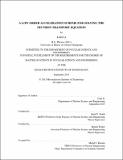A low order acceleration scheme for solving the neutron transport equation
Author(s)
Li, Lulu, Ph. D Massachusetts Institute of Technology
DownloadFull printable version (1.876Mb)
Other Contributors
Massachusetts Institute of Technology. Department of Nuclear Science and Engineering.
Advisor
Kord S. Smith and Benoit Forget.
Terms of use
Metadata
Show full item recordAbstract
The Methods of Characteristics (MOC) is a widely used technique for solving partial differential equations, and has been applied to the neutron transport problems for many years. The MOC method requires many transport iterations to solve large heterogeneous LWR reactor problems with high dominance ratio, and effective acceleration schemes are necessary to make MOC method practical. Various acceleration methods have been developed using low-order diffusion methods for approximating the scalar flux correction to the high-order scalar flux, and limited work has been performed using a low-order transport solution to accelerate the high-order transport solution. This work proposes a Low Order Operator (LOO) acceleration scheme for accelerating the transport equation. More specifically, LOO uses a coarsely discretized grid and iteratively solves the low-order system using MOC transport approximations. By conserving the first-order spatial and angular moments, LOO is proposed to capture more angular effects compared with CMFD. Two variations of the LOO method, together with the CMFD method, are implemented in the OpenMOC framework, which is a 2D MOC solver written to solve the 2D heterogeneous reactor problems. Based on the test cases performed in this work, LOO tends to reduce the number of transport sweeps required compared with the commonly used CMFD acceleration method. LOO also does not rely on under-relaxation as CMFD does to converge typical LWR problems tested in this work. The advantage of LOO over CMFD is more profound for problems with strong angular effects.
Description
Thesis: S.M., Massachusetts Institute of Technology, Department of Nuclear Science and Engineering, 2013. This electronic version was submitted by the student author. The certified thesis is available in the Institute Archives and Special Collections. Cataloged from student-submitted PDF version of thesis. Includes bibliographical references (pages 111-115).
Date issued
2013Department
Massachusetts Institute of Technology. Department of Nuclear Science and EngineeringPublisher
Massachusetts Institute of Technology
Keywords
Nuclear Science and Engineering.